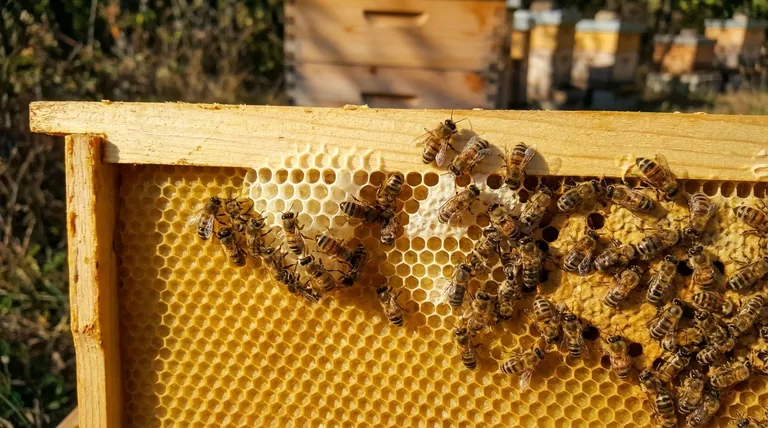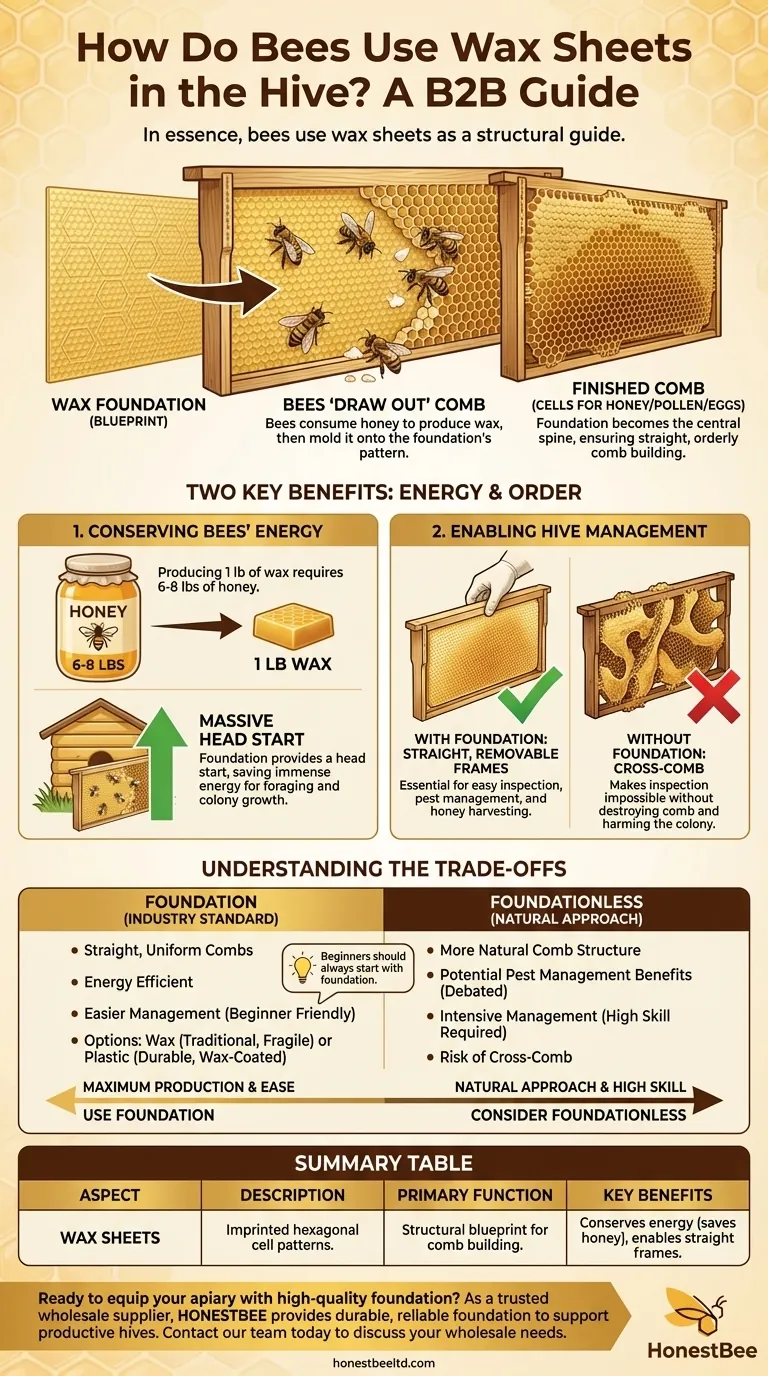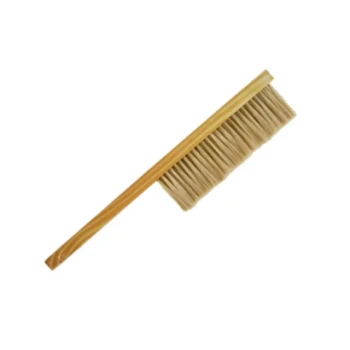In essence, bees use wax sheets as a structural guide. These sheets, known in beekeeping as foundation, are imprinted with hexagonal cell patterns that provide a blueprint, encouraging bees to build their wax comb in a straight, orderly fashion. This allows them to efficiently create the cells used for storing honey and pollen, and for the queen to lay eggs.
Foundation is a management tool that channels the bees' natural comb-building instincts. It saves the bees immense energy and provides the beekeeper with straight, removable frames, which are essential for hive inspection and honey harvesting.

Why Foundation is a Core Beekeeping Tool
A honey bee colony's primary goal is survival and expansion, which requires building wax comb. Foundation streamlines this natural process for the benefit of both the bees and the beekeeper.
The Purpose of a Blueprint
Bees are master architects, naturally building hexagonal cells. The foundation simply gives them a pre-made pattern to follow.
This ensures they build comb directly within the confines of the beekeeper's wooden frames, rather than in an irregular, free-form way.
The Process of "Drawing Out" Comb
When bees are given a sheet of foundation, they don't just use it as-is. They begin to "draw out" the comb.
This involves consuming honey, producing their own wax flakes from glands on their abdomens, and then molding that new wax on top of the foundation's pattern, building up the cell walls.
The foundation becomes the central spine of the finished comb.
The Two Key Benefits: Energy and Order
Using foundation is a standard practice because it offers clear advantages that support a healthy and productive hive.
Conserving the Bees' Energy
Producing beeswax is an incredibly resource-intensive process for honey bees. It is estimated that bees must consume six to eight pounds of honey to produce just one pound of wax.
By providing a foundation, the beekeeper gives the colony a massive head start. The bees can focus their energy on building out the cell walls rather than constructing the entire structure from scratch, saving a significant amount of honey.
Enabling Hive Management
Without foundation, bees will often build cross-comb—connecting comb across multiple frames or to the walls of the hive.
This makes it impossible for the beekeeper to remove a single frame for inspection without destroying the comb and potentially harming the queen. Straight, uniform combs built on foundation are critical for checking colony health, looking for pests, and harvesting honey.
Understanding the Trade-offs: Foundation vs. Foundationless
While foundation is the industry standard, some beekeepers opt for a "foundationless" approach. It's important to understand the different philosophies.
The Argument for Foundationless Beekeeping
Proponents argue that allowing bees to build their own comb entirely from scratch is more natural. Bees can build the exact cell size they prefer, which some believe can help in managing pests like Varroa mites.
However, this method requires more intensive management to prevent the inevitable cross-comb, often involving guide strips or frequent interventions. It is generally not recommended for beginners.
Types of Foundation: Wax vs. Plastic
Beekeepers have two main choices for foundation material, each with its own pros and cons.
Wax foundation is more traditional and readily accepted by bees. However, it can be fragile, especially in hot weather or during honey extraction.
Plastic foundation, typically coated in a thin layer of beeswax, is far more durable and resistant to warping. While most bees accept it readily, some colonies can be slower to build upon it.
Making the Right Choice for Your Goal
Your decision to use foundation, and what type, depends entirely on your beekeeping objectives.
- If your primary focus is maximum honey production and ease of management: Use plastic or wax foundation to ensure straight combs and conserve the bees' energy for foraging.
- If your primary focus is a "natural" approach and you are an experienced beekeeper: You might consider foundationless frames, but be prepared for the increased management challenges.
- If you are a beginner: Always start with foundation. It will make learning how to inspect your hive and manage your colony significantly easier and more rewarding.
Ultimately, foundation serves as a cooperative tool that helps both the beekeeper and the bees achieve a productive and organized hive.
Summary Table:
| Aspect | Description |
|---|---|
| Primary Function | Acts as a structural blueprint for bees to build comb. |
| Key Benefit for Bees | Conserves energy; saves 6-8 lbs of honey per 1 lb of wax produced. |
| Key Benefit for Beekeeper | Enables straight, removable frames for easy inspection and harvest. |
| Common Materials | Traditional beeswax or durable plastic (wax-coated). |
Ready to equip your apiary with high-quality foundation?
As a trusted wholesale supplier to commercial apiaries and equipment distributors, HONESTBEE provides durable, reliable foundation and beekeeping supplies that support productive and manageable hives. Our products are designed to help your bees conserve energy and maximize honey production.
Contact our team today to discuss your wholesale needs and how we can support your beekeeping success.
Visual Guide

Related Products
- Beeswax Foundation Sheets Beehive Foundation for Wholesale
- Notebook Style Beeswax Foundation Mould Wax Foundation Mold
- Manual Beeswax Comb Foundation Machine Wax Foundation Mill Embossing Machine
- Food Grade Plastic bee Foundation for Bee Frames
- Professional Frame Preparation: The HONESTBEE Electric Wire Embedder
People Also Ask
- What are wax sheets made of? A Guide to Pure Beeswax Foundation for Healthy Hives
- What are the sizes of natural worker and drone cells? Guide to Natural Beehive Architecture
- How do you store beeswax foundation? Prevent Wax Moth Damage and Preserve Quality
- What happens if foundation is given to colonies during a nectar dearth? Avoid Wasted Equipment and Stressed Bees
- What is 'foundation' in beekeeping, and why is it used? Optimize Hive Management & Honey Production



















